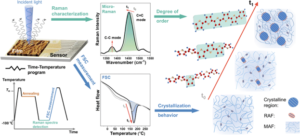Conjugated polymers (CPs) are transformative materials that have facilitated numerous advancements in the field of soft-matter electronics. Their low-cost, high structural tunability, and robust mechanical properties have made them desirable materials for broad range of applications, including in energy capture and storage, chemical and biological sensors, electronic skin, and electronic display devices. Recently, significant efforts have been made to develop intrinsically flexible and stretchable CPs and to understand the fundamental principles and structural characteristics that impart these elastomeric properties without impairment to charge transport. Central to this has been extensive characterization of the polymer morphology and microstructure, which yielded the discovery that local segmental order can facilitate efficient long-range charge transport in the amorphous domains of the polymer. However, directly probing the local segmental order in polymers and distinguishing the contributions of this domain towards the charge transport and physicochemical properties from that of the crystalline domains, which are defined by long-range ordering, remains challenging.
Now, a highly collaborative and extensive study by Luo et al. describes the development of a new technique for monitoring the subtle changes in the local segment order and amorphous fractions of the polymer microstructure by integrating Raman spectroscopy with fast-scanning calorimetry (FSC). The authors targeted a structurally diverse set of polymers to broadly classify their findings.
 |
| Figure 1. Modulating and probing microstructure of conjugated polymers by integrated ultrafast calorimetry and micro-Raman spectroscopy. Left: Schematic of this integrated technique. The time-temperature program used in this study was carried out by the chip sensor temperature controller. The growth of crystalline domain was identified by the evolution of melting peak collected through FSC. The degree of segmental order was analyzed by the Raman shift of C=C modes through resonant micro-Raman spectroscopy. Reproduced from DOI: 10.1039/D3MH00956D with permission from the Royal Society of Chemistry |
Namely, analogs based on poly(3-hexylthiophene-2,5-diyl) (P3HT) and poly{2,2′-[(2,5-bis(2-hexyldecyl)-3,6-dioxo-2,3,5,6- tetrahydropyrrolo[3,4-c ]pyrrole-1,4-diyl)dithiophene]- 5,5′-diyl-alt-thiophen-2,5-diyl} (PDPP3T or PDPPT), which are prevalent throughout organic electronics. The polymers were first subjected to a carefully devised time-temperature program to erase the thermal history of the polymers by first subjecting the polymer samples to temperatures above their melting point (Tm). Following subsequent thermal quenching and annealing steps, the Raman and FSC measurements were recorded. By monitoring the evolution of the Raman spectra and tracking the shifts in C=C/C-N stretches with increasing annealing time, minute changes in the segmental order could be monitored. It was observed that the extent of segmental order saturates before maximum crystallinity is achieved and that the annealing temperature could be specifically tailored for the polymers to achieve a highly ordered microstructure with desired levels of crystallinity.
Next, polymer segmental order was correlated with the segmental dynamics and charge transport properties by using alternating current (ac) chip-calorimetry and fabricating organic field effect transistors (OFETs). It was found that the rigid amorphous fraction (RAF) plays a significant role in promoting segmental order, and that there is a strong correlation between the polymer segmental order and the OFET charge-carrier mobility. Overall, the findings, magnitude, and scope of this study makes it a pivotal work for the field of organic electronics, and it should have resounding impact throughout material science.
To find out more, read the full manuscript here:
Real-time correlation of crystallization and segmental order in conjugated polymers
Shaochuan Luo, Yukun Li, Nan Li, Zhiqiang Cao, Song Zhang, Michael U. Ocheje, Xiaodan Gu, Simon Rondeau-Gagné, Gi Xue, Sihong Wang, Dongshan Zhou and Jie Xu
Mater. Horiz., 2023, Advance Article, DOI: 10.1039/D3MH00956D
About the blogger
 |
Robert M. Pankow is an Assistant Professor at The University of Texas at El Paso and a member of the Material Horizons Community Board. Dr. Pankow’s research focuses on conjugated polymer synthesis, sustainable chemistry, and organic electronics. You can follow him on X (formerly Twitter) @RobertPankow. |










